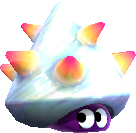Spinecone
| Spinecone | |||
|---|---|---|---|
 Screen-cropped asset from Super Mario Galaxy 2 | |||
| First appearance | Super Mario Galaxy 2 (2010) | ||
| Latest appearance | Super Mario Galaxy + Super Mario Galaxy 2 (2025) | ||
| |||
Spinecones[1] are horned turban snail-like enemies that appear in Super Mario Galaxy 2. Each Spinecone has a giant blueish-white cone-shaped shell adorned with orange spikes and has a purple head with a pair of skittish eyes that dart back and forth constantly. Spinecones first appear as uncommon enemies in the underwater portion of Starshine Beach Galaxy (all missions). They later appear as one of the main obstacles in Boo Moon Galaxy ("Haunting the Howling Tower" only). They move around very slowly and cannot be defeated.
Appearances[edit]
 marks missions where Spinecones are completely absent.
marks missions where Spinecones are completely absent. marks missions where Spinecones are loaded and may be visible but cannot be encountered directly.
marks missions where Spinecones are loaded and may be visible but cannot be encountered directly.
| Worlds | Galaxies | Missions | ||
|---|---|---|---|---|
| World 4 | Starshine Beach Galaxy | |||
| World 5 | Boo Moon Galaxy | |||
Gallery[edit]
Boo Mario among three Spinecones
Naming[edit]
Etymology[edit]
The English name "Spinecone," a play between "spine" and "pinecone," was first published on the English version of Mario Portal in 2022. The English edition of the Super Mario Bros. Encyclopedia refers to the enemy as the "Spiny Hermit,"[2] in reference to its superficial similarities to hermit crabs. Because this was used as a conjectural name by the Super Mario Wiki from 2010 to 2019, this is potentially a consequence of circular reporting.
Names in other languages[edit]
| Language | Name | Meaning | Notes |
|---|---|---|---|
| Japanese | トンガリ[3][4] Tongari |
Pointed | |
| French | Hermite piquant[5] | Spiky Hermit, in reference to bernard l'ermite ("hermit crab") | |
| German | Stachelkrebs[6] | Spiny Crab | |
| Italian | Paguspino[7] | Portmanteau between paguro ("hermit crab") and the masculine form of spina ("spike") | |
| Spanish (NOE) | Moluspica[8] | From molusco ("mollusc") and picar ("sting") |
References[edit]
- ^ English Super Mario Galaxy 2 entry on the official Mario Portal. nintendo.co.jp. Retrieved August 13, 2022. (Archived August 12, 2022, 23:39:46 UTC via archive.today.)
- ^ Roberts, Rachel, and Cardner Clark, editors (2018). "Super Mario Galaxy 2" in Super Mario Bros. Encyclopedia: The Official Guide to the First 30 Years (First English Edition). Milwaukie: Dark Horse Books. ISBN 978-1-50670-897-3. Page 159.
- ^ Hamamura, Koichi, Takeo Sakamoto, Ryo Aoyama, and Akimi Miyazawa, editors (2010). 『スーパーマリオギャラクシー2コンプリートガイド』. Tokyo: Enterbrain (Japanese). ISBN 978-4-04-726682-7. Page 152.
- ^ Sakai, Kazuya (ambit), kikai, Akinori Sao, Junko Fukuda, Kunio Takayama, and Ko Nakahara (Shogakukan), editors (2015). "Super Mario Galaxy 2" in『スーパーマリオブラザーズ百科: 任天堂公式ガイドブック』. Tokyo: Shogakukan (Japanese). ISBN 978-4-09-106569-8. Page 160.
- ^ Ardaillon, Joanna, and Victoria Juillard-Huberty, editors (2018). "Super Mario Galaxy 2" in Super Mario Encyclopedia. Translated by Fabien Nabhan. Toulon: Soleil Productions (French). ISBN 978-2-3020-7004-2. Page 160.
- ^ Scholz, Sabine, and Benjamin Spinrath, editors (2017). "Super Mario Galaxy 2" in Super Mario Encyclopedia - Die ersten 30 Jahre : 1985-2015. Translated by Yamada Hirofumi. Hamburg: Tokyopop (German). ISBN 978-3-8420-3653-6. Page 160.
- ^ Sakai, Kazuya (ambit), kikai, Akinori Sao, Junko Fukuda, Kunio Takayama, Ko Nakahara (Shogakukan), and Marco Figini, editors (2018). "Super Mario Galaxy 2" in Super Mario Bros. Enciclopedia. Translated by Marco Amerighi. Milan: Magazzini Salani (Italian). ISBN 889367436X. Page 160.
- ^ Sakai, Kazuya (ambit), kikai, Akinori Sao, Junko Fukuda, Kunio Takayama, and Ko Nakahara (Shogakukan), editors (2017). "Super Mario Galaxy 2" in Enciclopedia Super Mario Bros. 30ª Aniversario. Translated by Gemma Tarrés. Barcelona: Editorial Planeta, S.A. (European Spanish). ISBN 978-84-9146-223-1. Page 160.
